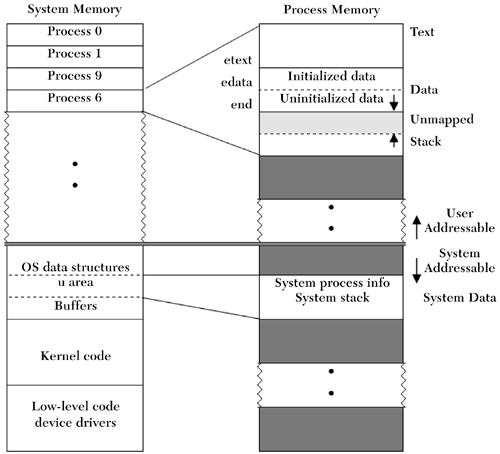Process Memory
Each process runs in its own private address space. When residing in system memory, the user process, like Gaul, is divided into three segments or regions : text, data , and stack .
- text segment The text segment (sometimes called the instruction segment) contains the executable program code and constant data. The text segment is marked by the operating system as read-only and cannot be modified by the process. Multiple processes can share the same text segment. Processes share the text segment if a second copy of the program is to be executed concurrently. In this setting the system references the previously loaded text segment rather than reloading a duplicate. If needed, shared text, which is the default when using the C/C++ compiler, can be turned off by using the -N option on the compile line. In Program 1.1, the executable code for the functions main and showit would be found in the text segment.
- data segment The data segment, which is contiguous (in a virtual sense) with the text segment, can be subdivided into initialized data (e.g., in C/C++, variables that are declared as static or are static by virtue of their placement) and uninitialized data. [4] In Program 1.1, the pointer variable cptr would be found in the initialized area and the variable buffer1 in the uninitialized area. During its execution lifetime, a process may request additional data segment space. In Program 1.1 the call to the library routine new in the showit function is a request for additional data segment space. Library memory allocation routines (e.g., new , malloc , calloc , etc.) in turn make use of the system calls brk and sbrk to extend the size of the data segment. The newly allocated space is added to the end of the current uninitialized data area. This area of available memory is sometimes called the heap . In Figure 1.9 this region of memory is labeled as unmapped.
[4] Some authors use the term BSS segment for the unitialized data segment.
Figure 1.9. System and process memory.

- stack segment The stack segment is used by the process for the storage of automatic identifiers, register variables, and function call information. The identifier i in the function main , buffer2 in the function showit , and stack frame information stored when the showit function is called within the for loop would be found in the stack segment. As needed, the stack segment grows toward the uninitialized data segment. The area beyond the stack contains the command-line arguments and environment variables for the process. The actual physical location of the stack is system-dependent.
![]()
Programs and Processes
- Introduction
- Library Functions
- System Calls
- Linking Object Code
- Managing Failures
- Executable File Format
- System Memory
- Process Memory
- The u Area
- Process Memory Addresses
- Creating a Process
- Summary
- Key Terms and Concepts
Processing Environment
- Introduction
- Process ID
- Parent Process ID
- Process Group ID
- Permissions
- Real and Effective User and Group IDs
- File System Information
- File Information
- Process Resource Limits
- Signaling Processes
- Command-Line Values
- Environment Variables
- The /proc Filesystem
- Summary
- Key Terms and Concepts
Using Processes
- Introduction
- The fork System Call Revisited
- exec s Minions
- Using fork and exec Together
- Ending a Process
- Waiting on Processes
- Summary
- Key Terms and Concepts
Primitive Communications
- Introduction
- Lock Files
- Locking Files
- More About Signals
- Signal and Signal Management Calls
- Summary
- Key Terms and Concepts
Pipes
Message Queues
- Introduction
- IPC System Calls: A Synopsis
- Creating a Message Queue
- Message Queue Control
- Message Queue Operations
- A ClientServer Message Queue Example
- Message Queue Class
- Summary
- Key Terms and Concepts
Semaphores
- Introduction
- Creating and Accessing Semaphore Sets
- Semaphore Control
- Semaphore Operations
- Semaphore Class
- Summary
- Key Terms and Concepts
Shared Memory
- Introduction
- Creating a Shared Memory Segment
- Shared Memory Control
- Shared Memory Operations
- Using a File as Shared Memory
- Shared Memory Class
- Summary
- Key Terms and Concepts
Remote Procedure Calls
- Introduction
- Executing Remote Commands at a System Level
- Executing Remote Commands in a Program
- Transforming a Local Function Call into a Remote Procedure
- Debugging RPC Applications
- Using RPCGEN to Generate Templates and a MAKEFILE
- Encoding and Decoding Arbitrary Data Types
- Using Broadcasting to Search for an RPC Service
- Summary
- Key Terms and Concepts
Sockets
- Introduction
- Communication Basics
- IPC Using Socketpair
- Sockets: The Connection-Oriented Paradigm
- Sockets: The Connectionless Paradigm
- Multiplexing I/O with select
- Peeking at Data
- Out of Band Messages
- Summary
- Key Terms and Concepts
Threads
- Introduction
- Creating a Thread
- Exiting a Thread
- Basic Thread Management
- Thread Attributes
- Scheduling Threads
- Using Signals in Threads
- Thread Synchronization
- Thread-Specific Data
- Debugging Multithreaded Programs
- Summary
- Nomenclature and Key Concepts
Appendix A. Using Linux Manual Pages
Appendix B. UNIX Error Messages
Appendix C. RPC Syntax Diagrams
Appendix D. Profiling Programs
Interprocess Communications in Linux: The Nooks and Crannies
ISBN: 0130460427
EAN: 2147483647
EAN: 2147483647
Year: 2001
Pages: 136
Pages: 136
Authors: John Shapley Gray
